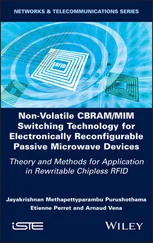Joel P. Dunsmore - Handbook of Microwave Component Measurements
Здесь есть возможность читать онлайн «Joel P. Dunsmore - Handbook of Microwave Component Measurements» — ознакомительный отрывок электронной книги совершенно бесплатно, а после прочтения отрывка купить полную версию. В некоторых случаях можно слушать аудио, скачать через торрент в формате fb2 и присутствует краткое содержание. Жанр: unrecognised, на английском языке. Описание произведения, (предисловие) а так же отзывы посетителей доступны на портале библиотеки ЛибКат.
- Название:Handbook of Microwave Component Measurements
- Автор:
- Жанр:
- Год:неизвестен
- ISBN:нет данных
- Рейтинг книги:5 / 5. Голосов: 1
-
Избранное:Добавить в избранное
- Отзывы:
-
Ваша оценка:
- 100
- 1
- 2
- 3
- 4
- 5
Handbook of Microwave Component Measurements: краткое содержание, описание и аннотация
Предлагаем к чтению аннотацию, описание, краткое содержание или предисловие (зависит от того, что написал сам автор книги «Handbook of Microwave Component Measurements»). Если вы не нашли необходимую информацию о книге — напишите в комментариях, мы постараемся отыскать её.
Handbook of Microwave Component Measurements — читать онлайн ознакомительный отрывок
Ниже представлен текст книги, разбитый по страницам. Система сохранения места последней прочитанной страницы, позволяет с удобством читать онлайн бесплатно книгу «Handbook of Microwave Component Measurements», без необходимости каждый раз заново искать на чём Вы остановились. Поставьте закладку, и сможете в любой момент перейти на страницу, на которой закончили чтение.
Интервал:
Закладка:
6 Chapter 6Figure 6.1 Relative gain of an amplifier versus compression level.Figure 6.2 Amplifier pretest: a wide band sweep looks for instability, and c...Figure 6.3 Typical plot showing S‐parameters, gain, solation, input, and out...Figure 6.4 Match‐corrected power measurements of an amplifier.Figure 6.5 Match‐corrected powers with software Rx‐leveling.Figure 6.6 Typical configuration for measuring DC power consumption.Figure 6.7 Measurement output power and DC current, for three different inpu...Figure 6.8 S‐parameters, K‐factor, and max stable gain.Figure 6.9 Resistance is added to the input network to improve the stability...Figure 6.10 Circuit response after matching.Figure 6.11 Stability circles at the center frequency.Figure 6.12 Mu1 and Mu2 for a conditionally stable amplifier.Figure 6.13 Mu1 and Mu2 for an amplifier after port matching to make it unco...Figure 6.14 Available gain of an amplifier computed from the output match (G...Figure 6.15 Transduce gain for an amplifier between two filters (dark trace)...Figure 6.16 The overall gain from embedding the filter response using port m...Figure 6.17 Detecting the onset of compression.Figure 6.18 CW power sweep to find compression.Figure 6.19 Back‐off and X‐Y methods of finding compression.Figure 6.20 Phase vs. drive and AM‐to‐PM.Figure 6.21 Swept frequency 1 dB compression measurements.Figure 6.22 A 3‐D surface of compression versus frequency and input power.Figure 6.23 S21 gain of an amplifier in compression, normal and with match c...Figure 6.24 Swept power PAE (upper); swept frequency PAE (lower).Figure 6.25 PAE versus power and frequency on a 3‐D surface.Figure 6.26 Error‐corrected measurements on a high‐gain amplifier.Figure 6.27 VNA block diagram with port 1 coupler reversed.Figure 6.28 S21 noise on a high gain amplifier with various settings; S11, S...Figure 6.29 Configuration for high power drive using rear panel loops for te...Figure 6.30 High power drive with external couplers.Figure 6.31 Measurement setup for +46 dBm maximum power.Figure 6.32 Configuration for high power test where the load changes with po...Figure 6.33 Timing diagram for wideband pulsed measurements.Figure 6.34 Narrowband pulse measurement spectrum and time measurement.Figure 6.35 Pulsed RF amplifier measurement show a 1 power before and after R...Figure 6.36 Pulse measurement shows gain, phase, and output power of an ampl...Figure 6.37 A narrowband mode pulse profile on a narrow pulse.Figure 6.38 Pulse‐to‐pulse measurements.Figure 6.39 Pulse profile showing DC measurements and PAE.Figure 6.40 Spectrum plot of an amplifier's harmonic response.Figure 6.41 Setting up for a harmonic measurement.Figure 6.42 Defining harmonic measurement parameters.Figure 6.43 Harmonic measurements on a VNA.Figure 6.44 Evaluating VNA harmonics: source harmonics (upper); receiver har...Figure 6.45 A harmonic enhancement circuit with its frequency response.Figure 6.46 Doherty amplifier block diagram.Figure 6.47 Driving an amplifier from a dual source VNA.Figure 6.48 Frequency sweep of Doherty amplifier.Figure 6.49 Power sweep of a Doherty amplifier.Figure 6.50 Power and PAE versus phase of the input.Figure 6.51 S21, S22, and T22 terms as a function of input power.Figure 6.52 The vector effect of a 2 and a 2* on apparent reflection.Figure 6.53 Illustration of a source and load‐pull system.Figure 6.54 Block diagram of a VNA with active load‐pulling.Figure 6.55 Active load‐pull showing output power and effective Hot‐ S 22.Figure 6.56 Schematic for an X‐parameter based Load‐pull simulation.Figure 6.57 Comparing X‐parameter simulated load‐pull with real load‐pull va...Figure 6.58 PAE contours versus load impedance.Figure 6.59 Output ( b 2) spectrum of an amplifier with a single input signal....Figure 6.60 Traditional Hot‐ S 22measure of a total reflection from an open p...Figure 6.61 Traditional Hot‐ S 22, showing the output reflection of the amplif...Figure 6.62 Spectrum of traditional Hot‐ S 22with a non‐linear amplifier.Figure 6.63 Swept frequency response, linear and high power, showing normal ...Figure 6.64 Gain versus power for an amplifier, comparing traditional 2‐port...Figure 6.65 S 22and Hot‐ S 22for a power sweep.Figure 6.66 LogMag of S 22and Hot‐ S 22in a power sweep.Figure 6.67 X s(2,2) and X t(2,2) versus drive power.
7 Chapter 7Figure 7.1 Input, LO, and output wave forms from a single‐balanced mixer.Figure 7.2 Conduction of a double‐balanced mixer.Figure 7.3 Image reject and IQ mixer topologies: standard topology (upper), ...Figure 7.4 Graphical representation of signals at the input and output of a ...Figure 7.5 Schematic of a normal (a) and image (b) mixers showing incident a...Figure 7.6 Schematic representations of mixers with nonideal responses.Figure 7.7 Actual circuit (a) and equivalent circuit at the RF (b) for a sou...Figure 7.8 Actual circuit (a) and equivalent circuit at the RF (b) for a sou...Figure 7.9 Understand the effect of phase shift of the LO: transmission phas...Figure 7.10 Typical output response of a mixer showing harmonics and spuriou...Figure 7.11 Diagram for mixer high‐order products.Figure 7.12 Multistage frequency converter.Figure 7.13 A mixer as a 12‐port device to describe all first‐order products...Figure 7.14 Mixer signals emitted or scattered (reflected) back from the inp...Figure 7.15 Typical connection for mixer measurements.Figure 7.16 Mixer measurement graphical user interface.Figure 7.17 A complete mixer “S‐parameter” measurements.Figure 7.18 Down/up‐conversion method for measuring phase.Figure 7.19 Phase response using down/up‐conversion.Figure 7.20 Vector mixer measurement system using a parallel path.Figure 7.21 Phase deviation for a mixer using the parallel (VMC) method.Figure 7.22 The synchronous sweeping is accomplished by a common reference a...Figure 7.23 Amplitude and phase response of a single receiver in a normal VN...Figure 7.24 Phase response of the B and R1 receivers a standard VNA (upper p...Figure 7.25 Phase stitching at synthesizer band breaks.Figure 7.26 The phase response of the IPwr and OPwr, with phase stitching is...Figure 7.27 Comparison of three methods measurement for phase deviation.Figure 7.28 Comparison of group delay responses for various methods, each of...Figure 7.29 Defining a swept LO measurement using a GUI.Figure 7.30 Fixed IF, swept RF/LO measurement of a mixer for two different I...Figure 7.31 Measuring phase response of multichannel fixed IF converters.Figure 7.32 Setup for swept LO phase‐difference measurement.Figure 7.33 Gain comparison and path‐to‐path phase difference of a multichan...Figure 7.34 Measuring the absolute phase response of a mixer.Figure 7.35 Absolute phase response of a mixer under swept LO conditions.Figure 7.36 Three‐mixer method of for measuring mixer phase on a VNA.Figure 7.37 Amplitude response of Mixer A measured using SMC and three‐mixer...Figure 7.38 The reflection method of mixer characterization is essentially a...Figure 7.39 Mixer characterized using the reflection method.Figure 7.40 The phase and delay response of a phase reference.Figure 7.41 Calibration of the VNA using a phase reference.Figure 7.42 Measured amplitude and phase response of the phase reference at ...Figure 7.43 Amplitude, phase deviation, and delay of the b 2 receiver in norm...Figure 7.44 Upper: individual input and output response of the VNA receiver ...Figure 7.45 Receiver tracking for mixer test plotted as a function of VNA re...Figure 7.46 Raw and correct delay response of a mixer.Figure 7.47 Comparing the three mixer‐phase calibration methods.Figure 7.48 Delay and gain measurements with different LO frequencies.Figure 7.49 Mixer parameters SC 21and S 11, and S 33(LO match) while making a...Figure 7.50 LO power effects on SC 21over a range of RF/IF frequencies.Figure 7.51 RF conversion gain versus frequency for various LO drive levels ...Figure 7.52 Normalized conversion gain versus frequency for various RF drive...Figure 7.53 Conversion gain vs. RF drive for several different fixed LO powe...Figure 7.54 Automated GCA measurements for the same mixer with various LO dr...Figure 7.55 Setup for measuring mixer IMD.Figure 7.56 Third‐ and fifth‐order IM product versus LO power, as well as ou...Figure 7.57 Spectrum plot of IM products at RF = −5 dBm, LO = −9 dBm.Figure 7.58 Third‐ and fifth‐order IMD power versus RF power, as well as IIP...Figure 7.59 Swept RF power IM3 and IIP3 with different LO drives.Figure 7.60 Upper: mixer IIP3 and gain versus frequency for three different ...Figure 7.61 Magnitude, phase, and delay response of a frequency doubler.Figure 7.62 Segment table for higher order products measurement.Figure 7.63 Higher‐order products measured using overlapped segments.Figure 7.64 Higher‐order products as a function of LO drive power.Figure 7.65 Using DIQ to measure higher‐order products.Figure 7.66 Measure of spurs versus LO drive power.Figure 7.67 Segment sweep provides a way to properly create a swept LO delay...Figure 7.68 Background acquisitions for software locking of an embedded LO....Figure 7.69 Comparison of software versus hardware locking for embedded LO m...Figure 7.70 Measurement setup for IQ up‐converter testing.Figure 7.71 IQ up‐converter setup UI.Figure 7.72 Example trace definitions for IQ up‐converters.Figure 7.73 Measurement of IQ up‐converter.Figure 7.74 LO feed‐through, image rejection and gain (upper); I/Q input imb...Figure 7.75 Image rejection as a function of amplitude and phase imbalance....Figure 7.76 Image rejection after a fixed phase and amplitude offset in the ...Figure 7.77 Measurement block diagram for an I/Q down‐converter.Figure 7.78 IQ power and image power on an IQ down‐converter.Figure 7.79 I and Q individual and relative amplitude (upper), and phase (lo...
Читать дальшеИнтервал:
Закладка:
Похожие книги на «Handbook of Microwave Component Measurements»
Представляем Вашему вниманию похожие книги на «Handbook of Microwave Component Measurements» списком для выбора. Мы отобрали схожую по названию и смыслу литературу в надежде предоставить читателям больше вариантов отыскать новые, интересные, ещё непрочитанные произведения.
Обсуждение, отзывы о книге «Handbook of Microwave Component Measurements» и просто собственные мнения читателей. Оставьте ваши комментарии, напишите, что Вы думаете о произведении, его смысле или главных героях. Укажите что конкретно понравилось, а что нет, и почему Вы так считаете.












